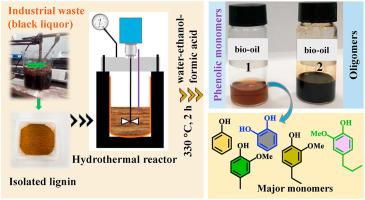Biomass & Bioenergy ( IF 5.8 ) Pub Date : 2021-08-24 , DOI: 10.1016/j.biombioe.2021.106204 Masud Rana 1 , Theoneste Nshizirungu 1 , Jeong-Hun Park 1

|
In this study, synergistic effect of a mixture solvent of water-ethanol-formic acid was investigated for the depolymerization of concentrated acid hydrolysis lignin (CAHL, isolated from industrial black liquor waste; source: pine wood) to produce phenolic monomers. The effects of solvent ratios, reaction temperature and time on CAHL depolymerization and the distribution of products were also explored. The highest bio-oil yield of 64.24 wt% containing 23.02 wt% monomers was obtained at 330 °C for 2 h with a water-ethanol-formic acid ratio of 1:1:0.4. Ethanol played an important role in increasing the solubility of CAHL and partly suppressing the repolymerization of reactive intermediates, while formic acid enhanced lignin depolymerization through an acid-catalyzed reaction and efficaciously preventing the repolymerization of unstable intermediates generated. Among the different monomers, 4-propylguaiacol (5.51 wt%), 4-methylguaiacol (3.43 wt%), catechol (3.02 wt%), 4-ethylguaiacol (2.73 wt%) and phenol (2.11 wt%) were identified as the major compounds in phenol-rich bio-oils. The MALDI-TOF MS spectra revealed that the oligomers present in the bio-oil were composed of dimers and trace amounts of trimer type compounds. Meanwhile, GPC results showed that CAHL (Mw = ~2156 g/mol) was efficiently depolymerized into lower molecular weight (Mw = 887 g/mol) compounds.
The process parameters, such as water/ethanol ratio, FA-to-water/ethanol ratio, reaction temperature and time were also optimized using a central composite rotatable design (CCRD) in response surface methodology (RSM). ANOVA results showed that reaction temperature and time had highly significant effect (ρ < 0.05) on the yield of bio-oil. The depolymerization approach and outcomes of this study suggest that this method is efficient for pulp and paper industry waste management and production of value-added chemicals.
中文翻译:

水-乙醇-甲酸对工业废(黑液)木质素解聚酚类单体的协同作用
在这项研究中,研究了水-乙醇-甲酸混合溶剂对浓酸水解木质素(CAHL,从工业黑液废物中分离;来源:松木)解聚以产生酚类单体的协同作用。还探讨了溶剂比例、反应温度和时间对 CAHL 解聚和产物分布的影响。在 330°C 下 2 小时,水-乙醇-甲酸比为 1:1:0.4,获得最高生物油产量 64.24 wt%,含 23.02 wt% 单体。乙醇在增加 CAHL 的溶解度和部分抑制活性中间体的再聚合方面发挥了重要作用,而甲酸通过酸催化反应增强木质素解聚并有效防止生成的不稳定中间体的再聚合。在不同的单体中,4-丙基愈创木酚 (5.51 wt%)、4-甲基愈创木酚 (3.43 wt%)、邻苯二酚 (3.02 wt%)、4-乙基愈创木酚 (2.73 wt%) 和苯酚 (2.11 wt%) 被确定为主要的富含苯酚的生物油中的化合物。MALDI-TOF MS 光谱显示生物油中存在的低聚物由二聚体和痕量的三聚体类型化合物组成。同时,GPC 结果显示 CAHL ( MALDI-TOF MS 光谱显示生物油中存在的低聚物由二聚体和痕量的三聚体类型化合物组成。同时,GPC 结果显示 CAHL ( MALDI-TOF MS 光谱显示生物油中存在的低聚物由二聚体和痕量的三聚体类型化合物组成。同时,GPC 结果显示 CAHL (M w = ~2156 g/mol) 被有效地解聚成较低分子量 ( M w = 887 g/mol) 的化合物。
还使用响应面法 (RSM) 中的中心复合旋转设计 (CCRD) 优化了工艺参数,例如水/乙醇比、FA 与水/乙醇比、反应温度和时间。方差分析结果表明,反应温度和时间对生物油的产率有非常显着的影响(ρ < 0.05)。本研究的解聚方法和结果表明,该方法对于纸浆和造纸工业废物管理和增值化学品的生产是有效的。









































 京公网安备 11010802027423号
京公网安备 11010802027423号